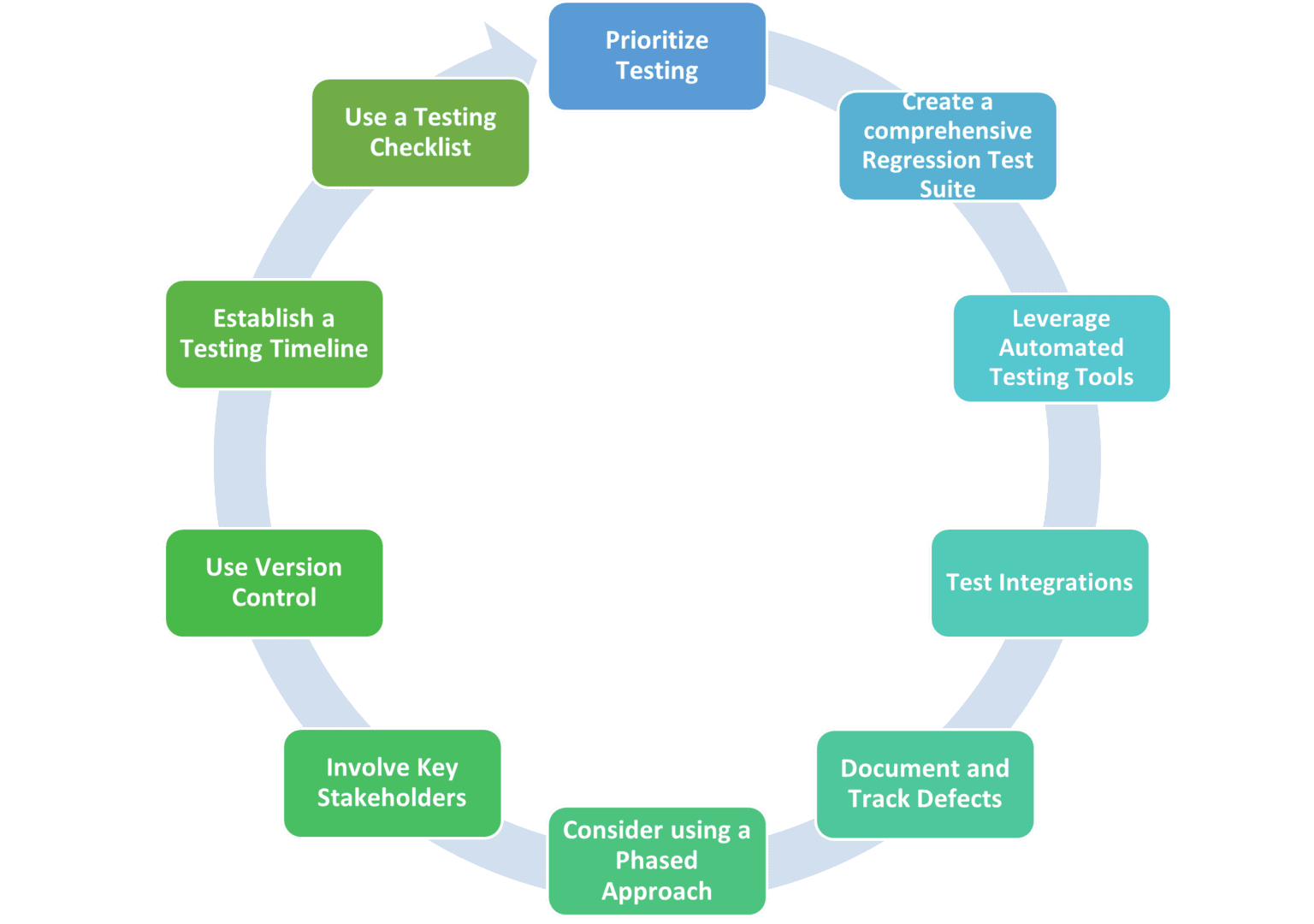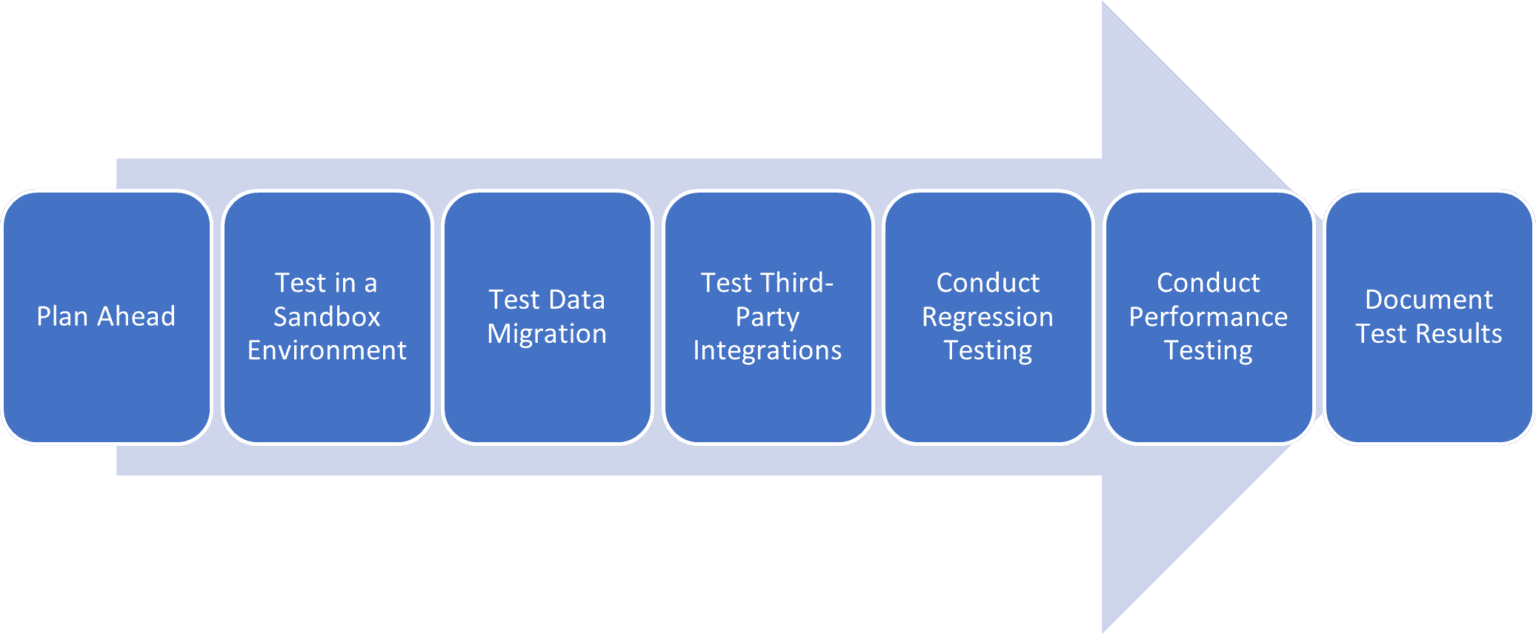- August 14, 2023
- Posted by: Kavitha PR
- Category: Digital Assurance

Upgrading to a new version of Dynamics can be a significant undertaking, and it’s crucial to ensure that everything works as expected after the upgrade. Testing is an essential part of the upgrade process, and it should be performed thoroughly to avoid any issues that could affect the system’s stability or functionality.
Best practices to follow when performing Dynamics upgrade testing:
Plan Ahead:
Before commencing the upgrade process, it is crucial to carefully plan the testing approach. This includes developing a comprehensive test plan that encompasses all the scenarios that need to be tested, including both functional and non-functional aspects. This will guarantee adequate coverage of all critical areas of the system during the testing phase.
It is also important to prioritize the test approach to avoid insufficient or excessive testing. Therefore, it is advisable to consult with the technical expert from the Engineering team initially. The engineer can provide recommendations on any necessary additions or exclusions to the test scope and help finalize the test plan.
Test in a Sandbox Environment:
It is always a good practice to test upgrades in a separate sandbox environment that mimics the production environment. This provides a safe and secure environment to thoroughly test the upgraded system’s features and functionalities. It ensures that any issues discovered during testing do not have an impact on the live system. Furthermore, it allows for multiple iterations of testing without jeopardising data integrity or causing downtime.
Test Data Migration:
If data migration is a part of the upgrade process, it becomes crucial to thoroughly test the migration process itself. It is imperative to ensure that all data is transferred correctly, and that data integrity is maintained throughout the process. This entails verifying that the migrated data appears as expected in the new system and aligns with the intended outcomes.
By conducting comprehensive tests on the migrated data, you can identify any inconsistencies, errors, or discrepancies that may have occurred during the migration. This level of meticulous testing guarantees a seamless transition and minimizes the risk of data loss or corruption, providing confidence in the integrity and reliability of the upgraded system.
Test Third-Party Integrations:
When upgrading the Dynamics system, it is crucial to thoroughly test any third-party integrations that are in place. This testing should cover both inbound and outbound data transfers and verify that the integrations continue to work after the upgrade.
This involves conducting end-to-end testing scenarios that simulate real-world data exchanges between the Dynamics system and the integrated systems. By executing these tests, any potential compatibility issues, data inconsistencies, or disruptions in the information flow can be identified and addressed promptly.
By thoroughly testing third-party integrations, the upgraded Dynamics system can maintain robustness, reliability, and seamlessness in its operation.
Conduct Regression Testing:
Regression testing is a vital component of the upgrade process as it aims to verify that the upgraded Dynamics system does not introduce any new issues or bugs while maintaining the previously working functionality. This type of testing ensures that all the previously working functionality is thoroughly tested to validate its proper functioning in the upgraded environment.
Automated testing tools and frameworks can significantly aid in performing regression testing efficiently by automating repetitive test cases and facilitating test coverage. This approach allows for quick and consistent execution of test cases, reducing the testing effort and providing faster feedback on the system’s functionality.
The importance of regression testing lies in its ability to uncover hidden defects, compatibility issues, or unintended consequences of the upgrade process. By identifying and addressing these issues early on, you can mitigate risks, prevent system disruptions, and maintain a high level of user satisfaction.
Overall, regression testing serves as a critical quality assurance measure to validate the stability and correctness of the upgraded Dynamics system. It provides confidence that the system continues to function as expected, preserving the existing functionality, and ensuring a smooth transition for end-users.
Conduct Performance Testing:
Performance testing is critical, especially if the new version of Dynamics introduces changes that may impact system performance. Test the system under varying loads to identify any performance issues and ensure that the system can handle the expected workload without degradation in its performance.
By identifying and addressing performance issues early on, we can optimise the system’s performance, enhance the user experience, and maintain productivity.
Document Test Results:
It’s essential to document all testing activities and results. This documentation can be used as a reference for future upgrades and to ensure that all areas of the system have been adequately tested.
Strategies for conducting regression testing during a Dynamics upgrade:
Dynamics upgrades can be difficult and time-consuming, but regression testing is essential to making sure everything functions as it should. Regression testing allows us to verify that the Dynamics system’s essential features and workflows have not been jeopardised or badly impacted by the upgrade. By enabling seamless functioning for end users, this helps to preserve the system’s dependability, stability, and usability.
Regression testing during a Dynamics upgrade can be done in the following ways:
 Prioritize Testing – Not all functionality in the Dynamics system is equal, and some features may be more critical than others. Therefore, it’s essential to prioritize the testing of critical functionality during the regression testing phase. Focus on the most frequently used features, Screens & Ribbon buttons that use JavaScript extensively, and any areas that have been impacted by the upgrade. Identify high-risk areas that are more prone to issues due to the upgrade and allocate more testing resources to those specific components. This approach ensures that the most critical and vulnerable parts of the system receive the necessary attention during regression testing. By prioritizing based on risk, we can ensure that any potential issues are addressed first.
Prioritize Testing – Not all functionality in the Dynamics system is equal, and some features may be more critical than others. Therefore, it’s essential to prioritize the testing of critical functionality during the regression testing phase. Focus on the most frequently used features, Screens & Ribbon buttons that use JavaScript extensively, and any areas that have been impacted by the upgrade. Identify high-risk areas that are more prone to issues due to the upgrade and allocate more testing resources to those specific components. This approach ensures that the most critical and vulnerable parts of the system receive the necessary attention during regression testing. By prioritizing based on risk, we can ensure that any potential issues are addressed first.
Create a comprehensive Regression Test Suite – Develop a comprehensive set of test cases specifically designed for regression testing. These test cases should cover all essential functionalities, workflows, and integration touch points within the Dynamics system. The test suite should encompass both positive and negative scenarios to thoroughly validate the system’s behaviour after the upgrade. Additionally, it should include verification of error messages, warnings, pop-ups, and scroll bar functions. These verifications should be conducted in one area, ensuring that they work similarly in other areas as well.
Leverage Automated Testing Tools – Utilize automated testing tools to streamline the regression testing process. Automated tests can significantly speed up the execution of test cases and help identify any unexpected issues efficiently. Additionally, they allow for easier retesting whenever new changes or updates are made to the system. With reusable test scripts, we can establish a strong foundation for ongoing regression testing throughout the lifecycle of the Dynamics system. This saves time and effort by eliminating the need to recreate test cases from scratch.
Test Integrations – Dynamics systems often integrate with other software, such as financial systems, marketing automation software, or customer relationship management tools. When upgrading Dynamics, it’s important to test these integrations thoroughly to ensure that they still function correctly.
Ensure a smooth Dynamics upgrade with comprehensive regression testing. Learn the best practices and strategies for conducting effective testing and minimize the risk of post-upgrade issues.
Document and Track Defects – Document and report all issues that are identified during regression testing. This helps ensure that issues are tracked and addressed before the system goes live. Use a formal bug-tracking system to manage issues and ensure that they are addressed in a timely manner.
Consider using a Phased Approach – A phased approach to regression testing can help ensure that all functionality is tested thoroughly. This involves testing the most critical functionality first and gradually expanding testing to cover less critical functionality. This approach can help identify and address issues early in the testing process.
Involve Key Stakeholders – End-users can provide valuable feedback during regression testing, as they can identify issues that may not be apparent to testers. Consider involving end-users in the testing process, or conducting user acceptance testing (UAT), to ensure that the system meets their needs. Their input and feedback can provide valuable insights into the expected behaviour of the system and help identify any deviations or issues that may arise during the upgrade.
Use Version Control – Version control is essential during a Dynamics upgrade to ensure that changes are tracked, and that the system can be rolled back if necessary. Use version control software to track changes and ensure that all testing is performed on the correct version of the system.
Establish a Testing Timeline – It’s important to establish a testing timeline and ensure that all testing is completed before the system goes live. This includes allowing time for testing, bug fixing, and retesting. The testing timeline should be communicated to all stakeholders to ensure that everyone is aware of the testing schedule.
Use a Testing Checklist – A testing checklist can help ensure that all testing is performed consistently and that nothing is missed. The checklist should include all test cases and scenarios that need to be tested, as well as any issues that have been identified and need to be addressed.
Do you also want to optimize your Dynamics upgrade process with effective regression testing, then book your free demo with us now.
In conclusion, Dynamics upgrade testing can be challenging, but organizations can overcome common challenges with the right approach and ensure a successful upgrade. Regression testing is an important part of the Dynamics upgrade process, and there are several strategies that organizations can use to conduct effective regression testing. By testing integrations, using a phased approach, involving end-users, establishing a testing timeline, and using a testing checklist, organizations can ensure that their Dynamics upgrade is successful and that the system functions correctly. By investing time and resources in regression testing, organizations can minimize the risk of issues arising after the system goes live and ensure that the upgrade is a success.





